California is home to an impressive diversity of scorpions, with species adapted to its deserts, forests, and coastal hills. These arachnids range from tiny, hard-to-spot dwellers of rocky slopes to large, hairy scorpions prowling the sandy dunes of the Mojave. Their appearances, behaviors, and habitats are as varied as the landscapes they inhabit.
Scorpions in California are often active at night, using their sensitive hairs and venomous stingers to hunt insects and small arthropods. While some may look intimidating, the majority have mild venom that poses little risk to humans. Understanding their roles in the ecosystem can lead to greater appreciation—and safer encounters—in the wild.
This article introduces 18 species of scorpions in California, complete with pictures and key identification details. From forest floors to desert basins, each profile includes information on size, markings, habitat, venom, and where you’re most likely to find them across the state.
Common Scorpions Found in California
Paruroctonus silvestrii (California Common Scorpion)
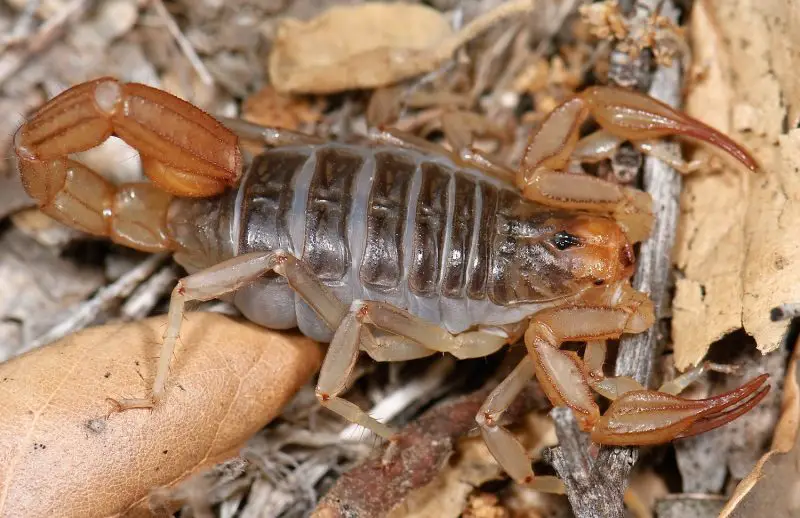
Paruroctonus silvestrii, commonly known as the California common scorpion, is one of the most widespread scorpions in the state. It typically measures between 4 to 45 millimeters in length and features a muted gray-brown coloration. One distinguishing feature is the presence of subtle striping on its tail segments, which helps differentiate it from other local species. This scorpion has a slender build and relatively thin pincers, allowing it to maneuver effectively in varied terrain.
The venom of P. silvestrii is mild and generally not dangerous to humans, though it can cause localized pain and swelling similar to a bee sting. It tends to be a nocturnal hunter, hiding under rocks, logs, or leaf litter during the day to avoid heat and predators. At night, it becomes active, using vibrations to detect prey such as insects, spiders, and other small arthropods. Its hunting behavior is opportunistic, and it rarely strays far from its hiding place unless in search of food or mates.
This species is found throughout much of California, particularly in coastal and inland areas. It is commonly seen in chaparral, scrubland, and even suburban settings where suitable cover is available. From the coastal ranges to interior valleys, P. silvestrii thrives in Mediterranean-type climates with warm summers and mild, wet winters. Its adaptability to different ecosystems makes it one of the most frequently encountered scorpions in the state.
Paruroctonus boreus (Northern Scorpion)
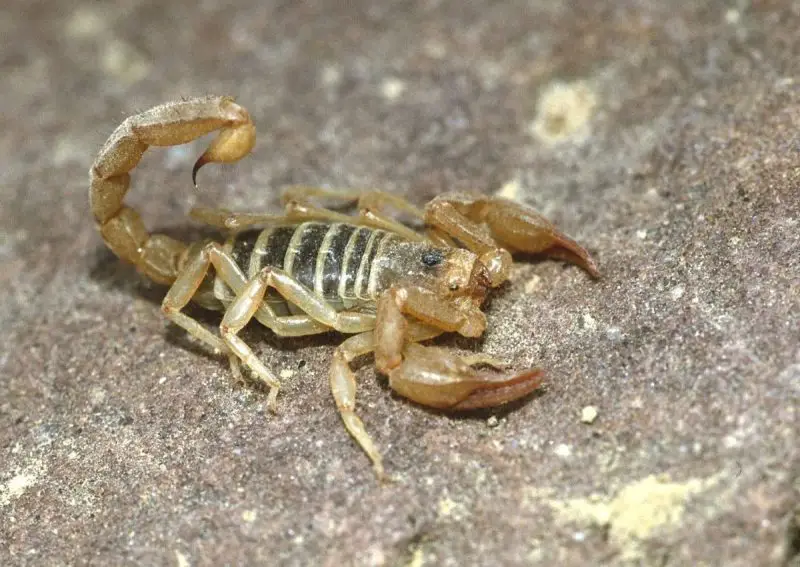
The Northern scorpion, Paruroctonus boreus, is among the hardiest of California’s native scorpions and is typically found in the northern and high-altitude regions of the state. Adults can grow up to 50 millimeters long and display a darker coloration, often brown or tan with prominent dark striping across the top of the body. These markings help them camouflage among rocks and soil in their native habitats, which tend to be more rugged and forested compared to those of other Paruroctonus species.
Although its sting is not considered medically significant, P. boreus does possess venom capable of subduing its prey. It is primarily insectivorous, preying on beetles, crickets, ants, and other small arthropods. This species is highly adapted to cooler environments and is often found in pine forests, rocky hillsides, and mountain slopes. It shows a preference for shaded and humid microhabitats and can be active even at relatively low temperatures compared to its desert-dwelling cousins.
Paruroctonus boreus is found in the northern parts of California, particularly in counties bordering Oregon and within mountainous regions such as the Sierra Nevada. Its range includes rocky outcrops, forest floors, and the edges of alpine meadows. This scorpion’s ability to survive in colder climates makes it unique among Californian scorpions, most of which prefer arid or semi-arid environments.
Paruroctonus mesaensis (Mesa Scorpion)

Paruroctonus mesaensis, or the Mesa scorpion, is a desert-adapted species most commonly found in Southern California’s sandy dune systems. This scorpion has a pale yellow to tan coloration, helping it blend into desert sand. Adults typically reach 2 to 3 inches (around 50 to 75 millimeters) in length, making it one of the larger members of its genus. Its long, slender appendages and light coloration are evolutionary traits for surviving the extreme heat and dryness of the desert.
This species is well adapted to arid environments and is a proficient burrower. During the heat of the day, it remains hidden in self-made tunnels or beneath rocks, emerging at night to hunt. Its venom is relatively mild, not dangerous to humans, and is used primarily to paralyze insects and small arthropods. P. mesaensis relies heavily on tactile cues and vibrations to locate prey in the loose sand and is known for its speed and agility on open desert terrain.
In California, P. mesaensis is mostly restricted to the deserts of the southeastern region, including parts of Riverside, Imperial, and San Bernardino counties. It favors open, sandy areas such as dunes and desert basins, often within the Colorado Desert. Its preference for loose sand and dry environments makes it less commonly encountered than other scorpions unless one is specifically searching desert landscapes at night with a UV light.
Paruroctonus borregoensis (Borrego Sand Scorpion)
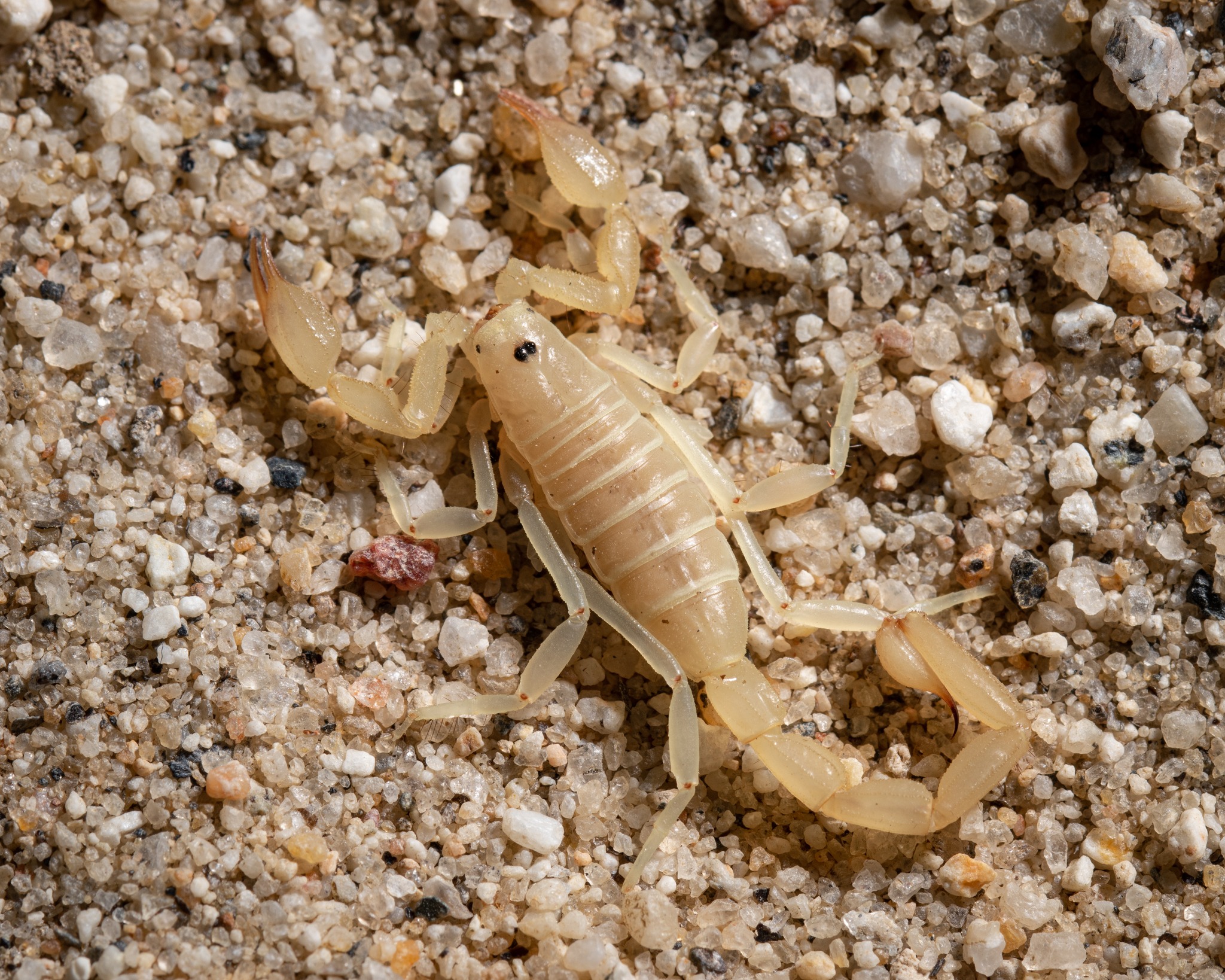
Paruroctonus borregoensis, the Borrego sand scorpion, is a medium-sized scorpion typically measuring between 30 to 35 millimeters in length. It has a pale beige or sandy brown coloration, which helps it blend seamlessly into the desert soil of its natural habitat. Though similar in appearance to other desert-dwelling species, P. borregoensis is distinguishable by subtle morphological traits and its more restricted geographic distribution.
Like many other Paruroctonus species, the Borrego sand scorpion is nocturnal and seeks shelter during the day under rocks or in burrows. It hunts actively at night, feeding on insects and other small arthropods. Its venom is not known to be medically significant to humans, typically causing only mild symptoms if stung. This scorpion plays an important role in the desert ecosystem as both predator and prey, and its behaviors are highly attuned to the extreme conditions of the region.
This species is endemic to southern California, especially in the deserts of San Diego and San Bernardino counties, including Anza-Borrego Desert State Park. It inhabits arid environments with sandy or gravelly soils and sparse vegetation. The species’ name is derived from the Borrego Valley, where it is most commonly observed, particularly on warm desert nights using UV flashlights.
Paruroctonus tulare (Tulare Basin Scorpion)
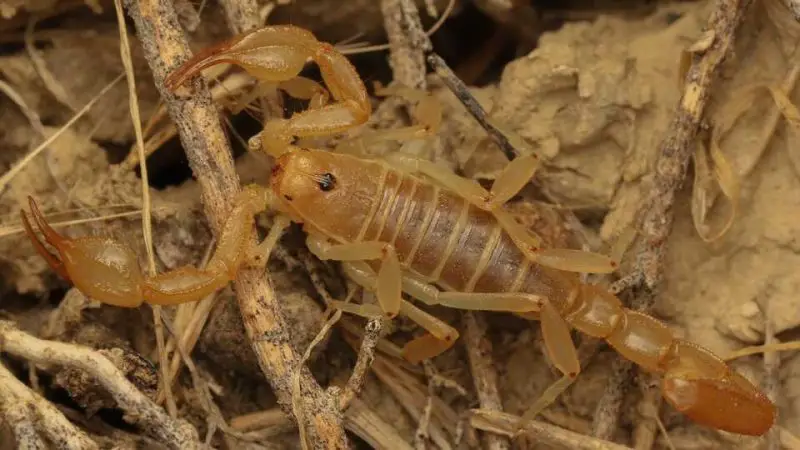
Paruroctonus tulare is a newly described species of scorpion, first officially documented in 2023. This species is native to the Tulare Basin within California’s San Joaquin Desert, an area that was once part of a large freshwater lake system. Adults are relatively small to medium in size and display cryptic sandy or brownish coloration. Because it was only recently identified, many of its physical and behavioral traits are still being studied, but it shares similarities with other desert-adapted Paruroctonus species.
This scorpion is believed to be a nocturnal predator, hunting insects and small invertebrates during the cooler hours of the night. Like its relatives, it likely possesses a mild venom not considered dangerous to humans. The Tulare Basin scorpion’s ecological role within its native environment is crucial, especially given the fragile and rapidly changing nature of California’s Central Valley ecosystems. It likely uses burrows or cracks in the soil for shelter during the hot daylight hours.
The known distribution of Paruroctonus tulare is limited to the Tulare Basin and adjacent parts of the southern San Joaquin Valley in California. This species’ discovery underscores the importance of preserving Central Valley desert habitats, many of which have been drastically altered by agriculture and development. Its existence in such a highly modified landscape highlights the resilience of native species and the ongoing need for conservation efforts.
Uroctonus mordax (California Forest Scorpion / Western Forest Scorpion)

Uroctonus mordax, commonly known as the California forest scorpion or Western forest scorpion, is frequently encountered in Northern California, especially in damp forested areas. Adults usually reach up to 2 inches in length and have a compact body with a rich dark brown coloration, well-suited for camouflage in leaf litter and under bark. Their slender pincers and relatively smooth exoskeleton make them visually distinct from desert species.
This species has a mild venom, roughly equivalent to a bee sting in terms of pain and risk. While not medically significant, a sting can cause temporary swelling, itching, or localized discomfort. U. mordax is nocturnal and highly secretive, remaining hidden under logs, stones, and bark during the day. At night, it emerges to prey on insects, beetles, and small arthropods. Its behavior is non-aggressive, and it typically avoids contact with humans.
Uroctonus mordax thrives in moist, shaded habitats and is especially common in redwood and oak forests. It ranges across the Bay Area, into the coastal mountain ranges and northward into Humboldt and Mendocino counties. The species is well-adapted to the cool, humid microclimates of California’s temperate forests and is one of the few scorpions found in such wet environments.
Uroctonites montereus
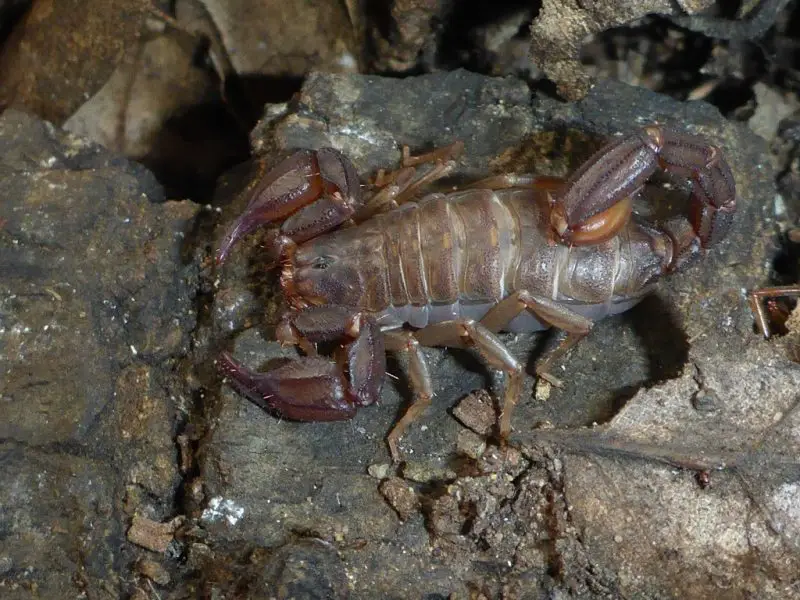
Uroctonites montereus is a lesser-known scorpion species native to the coastal hills and mountains of Central California. This small and elusive species belongs to a genus closely related to Uroctonus, but with more specialized habitat preferences. Its body is dark in color, often brown or blackish, and its overall size is relatively modest. Due to its cryptic nature, it is seldom seen and remains poorly understood.
The venom of U. montereus is believed to be weak and not harmful to humans, similar to other forest-dwelling scorpions. It likely leads a nocturnal life, hiding beneath rocks and within forest debris during the day. At night, it probably feeds on soft-bodied insects and arthropods. While not aggressive, it may rear up its tail if disturbed, though it is more likely to flee than fight.
This scorpion is primarily found in the coastal ranges stretching from San Mateo County southward. It inhabits hilly woodland environments, preferring undisturbed areas with rich leaf litter, decaying wood, and moist conditions. Because it is so rarely encountered and has a limited range, U. montereus is of interest to researchers studying biodiversity in California’s coastal ecosystems.
Anuroctonus pococki (California Swollen-Stinger Scorpion)

Anuroctonus pococki, known as the California swollen-stinger scorpion, is a striking species named for its visibly enlarged and banded tail segments. It typically grows to about 65 millimeters in length and has a sturdy, reddish-brown to tan body. The tail’s “pinstripe” pattern and bulbous metasoma make it easily recognizable among California scorpions.
This species has a painful but not dangerous sting. While the venom is not medically significant to healthy adults, a sting can cause intense localized pain and swelling. A. pococki is a burrowing species, known for digging deep and elaborate tunnels in loose soil. It spends the majority of the day hidden underground and emerges at night to hunt crickets, beetles, and other arthropods.
Anuroctonus pococki is found along the Southern California coast, particularly in semi-arid scrublands and foothill regions with loose, sandy or loamy soils. Its range includes parts of Ventura, Los Angeles, and San Diego counties. Because it tends to avoid human-altered landscapes, it is more likely to be encountered in wild, undisturbed coastal habitats.
Centruroides exilicauda (Baja California Bark Scorpion)
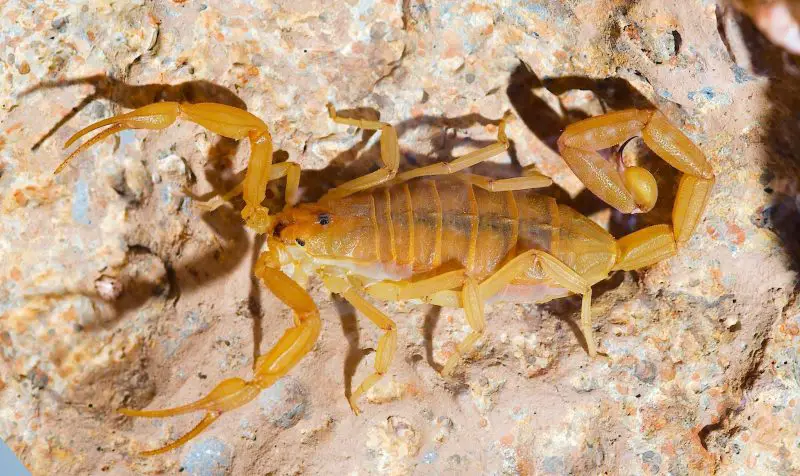
Centruroides exilicauda, also called the Baja California bark scorpion, is one of the more medically significant scorpions found in California. Adults range from 2 to 3 inches in length and are typically slender, with a long, narrow tail and thin pincers. Their coloration is usually pale yellow or tan with faint markings, which help them blend into desert and rocky environments.
This species has a relatively strong venom that can cause moderate to intense pain, numbness, or tingling at the sting site. Though rarely life-threatening, stings from C. exilicauda may require medical attention, particularly for children or those with allergies. Unlike ground-dwelling species, bark scorpions are climbers and often seek refuge in tree bark, woodpiles, crevices, and even human structures.
Centruroides exilicauda is distributed across Baja California and into southeastern parts of California, especially in Imperial County and along the lower Colorado River basin. It favors arid, rocky, and semi-urban areas, and is sometimes encountered in homes or garages. Its climbing behavior and stronger venom make it one of the more important scorpions to be aware of in southern desert regions.
Centruroides sculpturatus (Arizona Bark Scorpion)
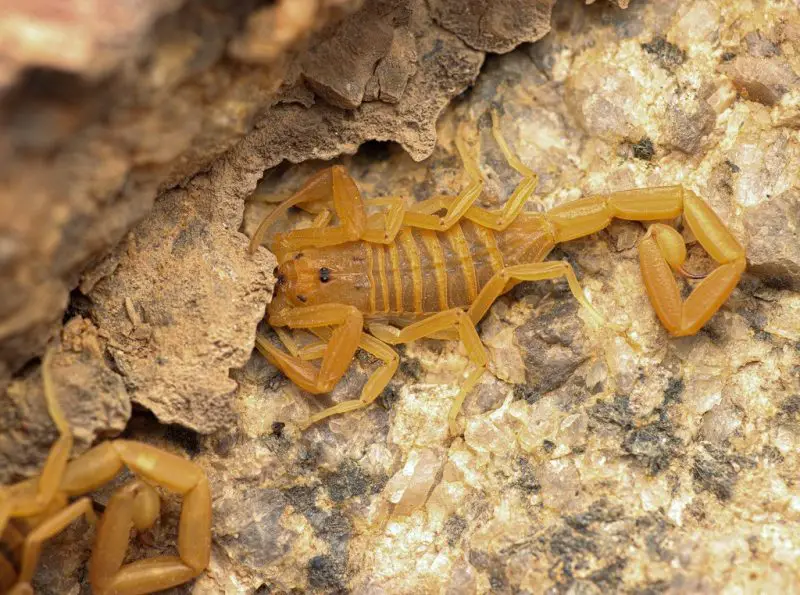
Centruroides sculpturatus, commonly known as the Arizona bark scorpion, is one of the most venomous scorpions in North America and occasionally appears in southeastern California. It is a slender species, typically reaching 2.5 to 3 inches in length, with a pale yellow to light brown body and an elongated tail. Its appearance is nearly identical to C. exilicauda, and the two were once considered the same species.
The sting of C. sculpturatus is significantly more painful than that of most other U.S. scorpions and can cause symptoms such as muscle spasms, intense pain, numbness, and vomiting. While deaths are extremely rare thanks to modern antivenom, the species is considered medically important and should be approached with caution. Like other bark scorpions, it is arboreal and frequently climbs vertical surfaces, including walls and trees.
Although its primary range is in Arizona, this species crosses into southeastern California, particularly in the Sonoran Desert regions of Riverside and Imperial counties. It prefers warm, rocky, and dry environments and is often found under tree bark, in rock crevices, and within human dwellings. Its ability to adapt to urban environments makes it a scorpion of concern in populated desert communities.
Hadrurus arizonensis (Desert Hairy Scorpion / Giant Hairy Scorpion)

Hadrurus arizonensis, commonly called the Desert Hairy Scorpion or Giant Hairy Scorpion, is the largest scorpion species in North America, reaching up to 14 centimeters (about 5.5 inches) in length. It has a striking appearance, with a robust body covered in fine yellowish hairs and darker coloration on the back and tail. Its large pedipalps (pincers) and bushy setae (sensory hairs) help detect vibrations and movement in its desert environment.
Despite its intimidating size, the venom of H. arizonensis is relatively mild, producing pain and swelling similar to a bee sting. It relies more on its powerful pincers to subdue prey such as beetles, crickets, other scorpions, and even small lizards. This species is nocturnal and highly adapted to desert life, spending the hot daylight hours in deep burrows to maintain moisture and avoid extreme heat. It is also one of the most long-lived scorpions, with lifespans reaching 20 years in captivity.
Hadrurus arizonensis is commonly found in the Mojave and Colorado deserts, including southeastern California. It thrives in arid, sandy, and rocky regions of counties like San Bernardino, Riverside, and Imperial. Its large size and distinctive hairs make it easily recognizable, especially when encountered at night using ultraviolet (UV) lights, under which it glows a bright greenish hue.
Hadrurus spadix (Giant Desert Hairy Scorpion)
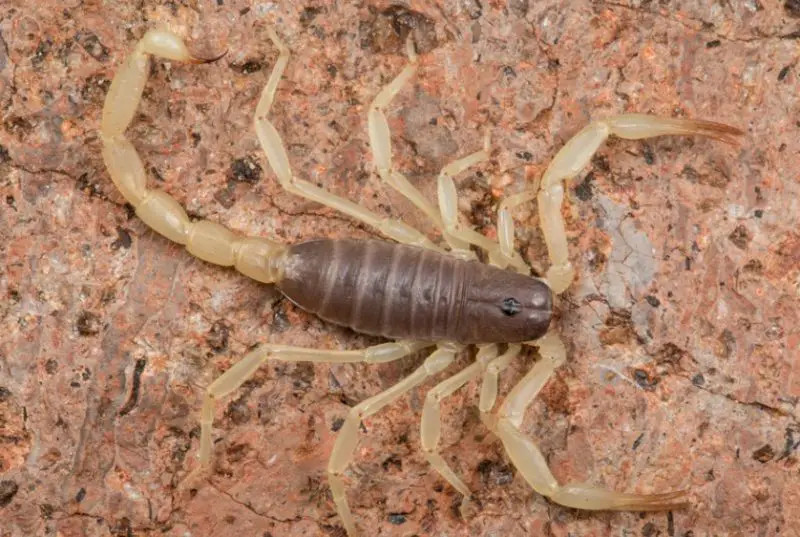
Hadrurus spadix, also known as the Giant Desert Hairy Scorpion, is closely related to H. arizonensis but represents a distinct species. It is similar in size and build, often growing up to 12–14 centimeters (around 5 inches), and also has dense sensory hairs along its body and limbs. However, it tends to have darker overall coloration, particularly a blacker tail and cephalothorax, setting it apart from its cousin.
This species has a venom profile similar to H. arizonensis, with stings that are not considered dangerous to humans. Instead of relying on its venom, H. spadix primarily uses its strength and large pincers to overpower prey. It is a burrower, spending most of its time underground in self-dug tunnels that can reach several feet in depth. At night, it emerges to hunt insects, arachnids, and small vertebrates that stray too close.
Hadrurus spadix inhabits desert regions of southeastern California, overlapping with the Mojave Desert and parts of the Colorado Desert. It shares similar ecological preferences with H. arizonensis, favoring arid, open habitats with loose, sandy, or gravelly soils. Though they may occur in overlapping areas, these two species maintain genetic distinctions and are rarely found sharing the same burrow or microhabitat.
Smeringurus mesaensis (Dune Scorpion / Dune Sand Scorpion)
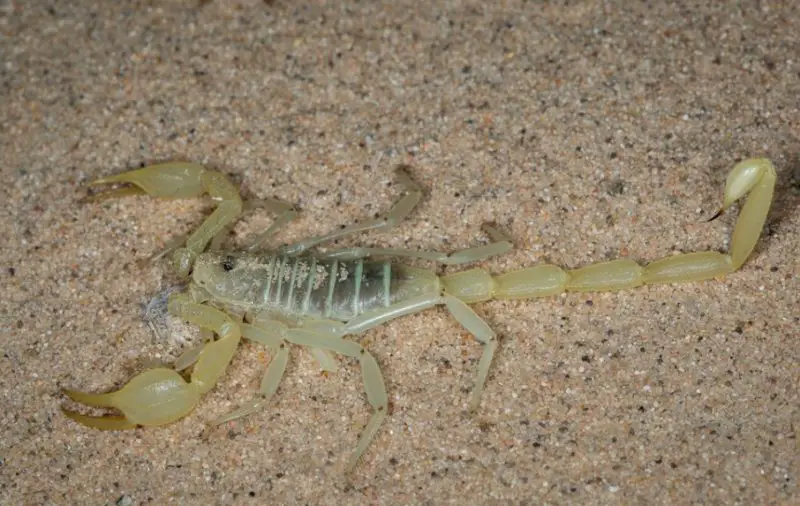
Smeringurus mesaensis, known as the Dune or Dune Sand Scorpion, is a desert-adapted species that inhabits loose sandy soils, especially in Southern California’s desert regions. Adults typically measure between 2.5 to 3 inches (about 65–75 mm) in length and have a pale yellow or beige body that blends perfectly with their environment. They are sleek and agile, with thin pincers and long legs suited for swift movement across open dunes.
The venom of S. mesaensis is mild and not considered medically significant. Though a sting may cause brief discomfort, it poses little danger to humans. This scorpion is a voracious nocturnal hunter, using its keen sensitivity to ground vibrations to locate prey beneath the sand. It frequently hunts insects, small spiders, and other invertebrates. Burrowing is a key survival strategy, helping it maintain body moisture and escape the desert heat during the day.
This species is found in California’s southeastern deserts, especially in sand dune systems within Riverside and Imperial counties. It favors open dune habitats with sparse vegetation and is often found in the Algodones Dunes and other parts of the Sonoran Desert. Because it is highly sensitive to disturbance, it is more commonly seen in undisturbed desert areas on warm, calm nights.
Vaejovis spinigerus (Striped-Tailed Scorpion / Stripe-Tail Scorpion)
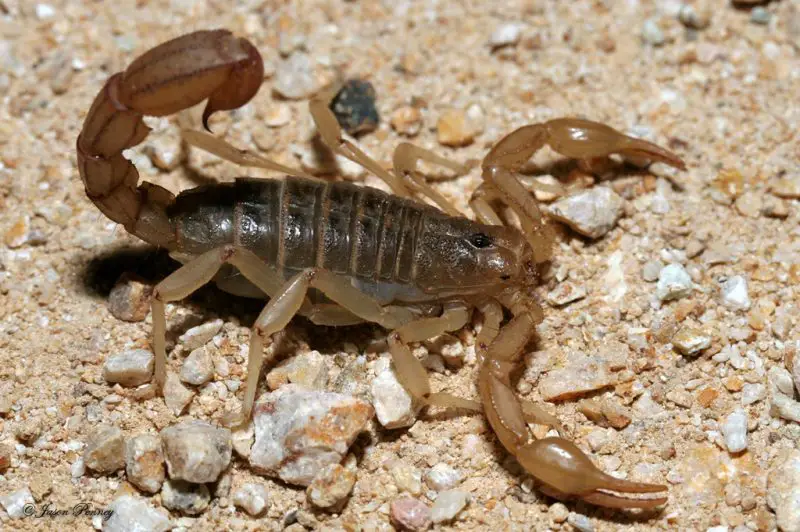
Vaejovis spinigerus, also known as the Striped-Tailed Scorpion or Stripe-Tail Scorpion, is a common inhabitant of the dry deserts and rocky outcrops of Southern California. Adults typically measure around 2 to 3 inches in length and feature a brown to tan body with distinct dark striping on the tail segments. These stripes are a key identification feature and help camouflage the scorpion among rocks and desert debris.
This species has a mild sting, usually comparable to a bee or wasp sting, with temporary pain and swelling in most cases. It is non-aggressive and will sting only when provoked or handled. V. spinigerus is nocturnal, emerging at night to feed on small insects, spiders, and occasionally centipedes. It prefers crevices, rock piles, and shaded areas for daytime shelter and is known for its ability to survive in arid and rocky terrain.
Vaejovis spinigerus is commonly found across the deserts of southeastern California, including the Mojave and Sonoran deserts. Its range includes Riverside, San Bernardino, and Imperial counties. It thrives in dry, rocky habitats with limited vegetation and can occasionally be found in suburban or rural structures near its natural desert environment.
Vaejovis confusus (Yellow Ground Scorpion / Confuse Scorpion)
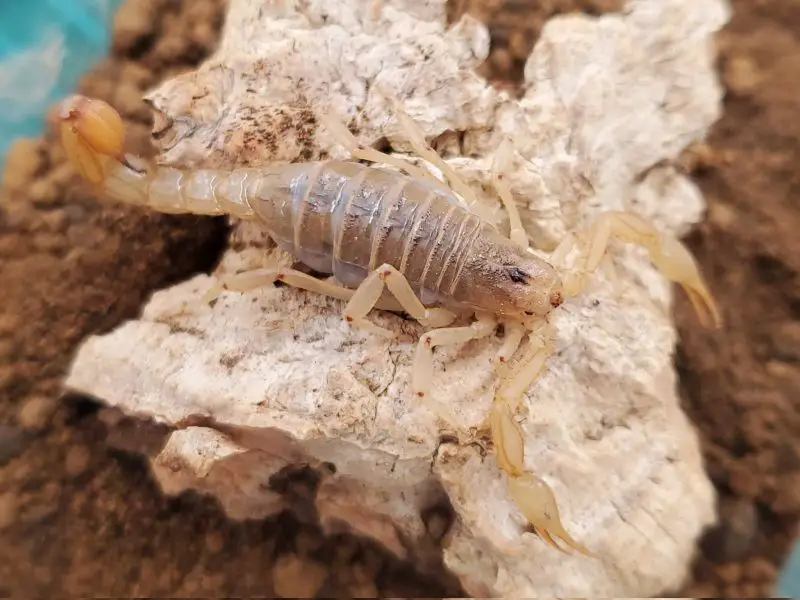
Vaejovis confusus, commonly known as the Yellow Ground Scorpion or Confuse Scorpion, is a small- to medium-sized species found in arid and mountainous environments. It typically ranges from 25 to 45 mm in length and displays variable coloration—usually yellowish to light brown—with subtle patterns or mottling along its body. The variability in its appearance is part of what earned it the name “confusus,” making field identification more challenging.
The venom of V. confusus is considered mild and poses minimal risk to humans. Like other members of the Vaejovis genus, it relies more on stealth and camouflage than aggression. It hides under rocks, bark, and leaf litter by day, emerging at night to hunt insects and other small arthropods. It uses its pincers to capture prey and its sting as a secondary measure. It is generally non-aggressive unless threatened.
This species is distributed across desert and montane regions in California, particularly in the Mojave Desert and parts of the Transverse and Peninsular ranges. It can be found in both lowland arid zones and higher elevations, especially in areas with loose soils and rocky outcroppings. Though not as commonly encountered as some desert species, it remains fairly widespread in suitable microhabitats.
Serradigitus gertschi (Sawfinger Scorpion)

Serradigitus gertschi, also called the Sawfinger Scorpion, is one of the smallest scorpions in California, measuring only about 12 mm (under half an inch) in length. It has a slender, almost delicate build with unusually long, thin pincers that resemble serrated or “saw-like” structures—hence its name. Its body is usually light brown or translucent, and its small size makes it extremely difficult to detect in the wild.
Despite its tiny stature, S. gertschi is a functional predator, feeding on mites, tiny insects, and other micro-arthropods. Its venom is very weak and not medically significant to humans, likely used to immobilize minute prey. It is nocturnal and reclusive, seeking refuge in sandy soils, under stones, or within crevices during the day. Its behavior is timid and cautious, and it relies heavily on its environment for protection.
This scorpion is primarily found along the Central Valley and coastal areas of California. Its preferred habitats include sandy or rocky slopes, often with minimal vegetation. Reports suggest that it may also inhabit canyon edges and foothill zones with dry, brittle terrain. Because of its size and elusive habits, S. gertschi is rarely encountered and easily overlooked by casual observers or hikers.
Wernerius inyoensis
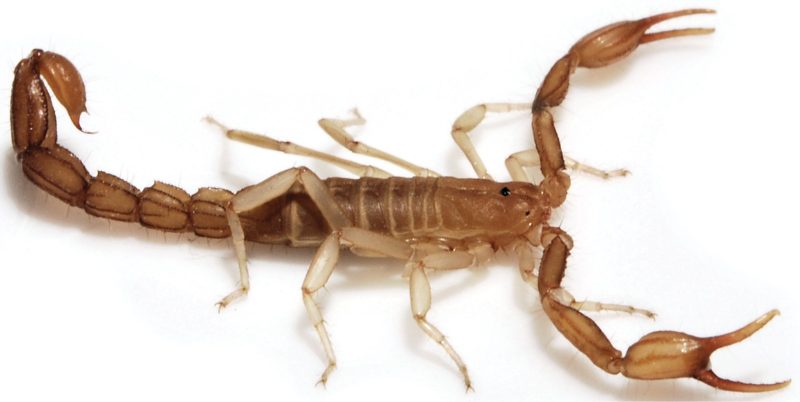
Wernerius inyoensis is a highly elusive scorpion species discovered in the remote Inyo Mountains near Death Valley, California. It is extremely small, averaging just 17 mm (about two-thirds of an inch), and has a pale to light brown body that blends in with desert rock and dust. This species is part of the rare genus Wernerius, which includes some of the least studied scorpions in North America.
Very little is known about the venom or behavior of W. inyoensis, but like its close relatives, it likely poses no threat to humans. Its sting is presumed to be mild and primarily used for subduing tiny prey. Due to its reclusive nature and rugged habitat, it is rarely observed. It is believed to live in cracks, beneath stones, and in sheltered rocky crevices, emerging briefly at night to hunt.
The known range of Wernerius inyoensis is limited to the Inyo Mountains in eastern California, near the harsh and arid conditions of Death Valley National Park. Its preference for high-elevation desert cliffs and isolated canyons makes it one of California’s most mysterious and least understood scorpions. Its discovery highlights the potential for undiscovered arthropod diversity in California’s most extreme landscapes.
Paruroctonus variabilis

Paruroctonus variabilis is an extremely rare scorpion species native to the Bay Area of California. This small, lightly built scorpion exhibits a sandy to pale brown coloration, allowing it to blend in with dry, grassy or scrubby environments. While morphologically similar to other Paruroctonus species, its identification requires expert knowledge due to subtle differences in size and structure.
Its venom is believed to be mild and non-dangerous to humans. P. variabilis is a nocturnal hunter, feeding primarily on small insects and arthropods. Like other desert-adapted scorpions, it spends daylight hours hidden in shallow burrows or under debris. Its secretive habits and limited geographic range make encounters with this species very rare, even among experienced field researchers.
Currently, Paruroctonus variabilis is known only from a few isolated sites around the Bay Area. It likely inhabits dry grasslands, rocky outcrops, and coastal foothills, though its precise distribution is not fully documented. Conservationists and taxonomists are interested in this species because of its restricted range and potential sensitivity to habitat disturbance in one of California’s most heavily developed regions.






